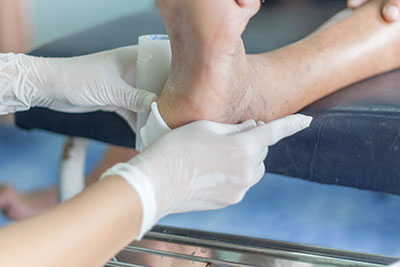- Home
- Advanced Treatments
- Wound Care Treatments
Wound Care Treatments
- Published 10/27/2022
- Last Reviewed 11/16/2022

No matter how cautious you are, cuts, scrapes, and even serious wounds happen. When these wounds happen on your toes, feet, or ankles, they can be difficult to heal and very painful.
Healthy, functional feet support your body through day-to-day life, so it’s important to take proper care of a foot wound from the very moment it occurs.
UFAI offers patients vacuum-assisted wound closure care that delivers negative pressure to speed up and promote healing and prevent wound infection.
Our wound care specialists utilize wound debridement to remove non-viable tissue from new or chronic wounds to promote healing.
If tissue destruction, infection, or disease affects a foot and makes it impossible to repair, that part may be removed by surgical amputation.
Our physicians can approach chronic wounds with a combination of two therapies: compression dressing and collagen dressing.
Nail avulsion is the separation of the toenail from the nail bed. This can be caused by trauma or injury that tears off part or all of the nail or performed as a medical procedure.
 I was traveling recently and injured my foot. Based on the recommendation of a friend (and after reading all the great reviews)...Sarah V.
I was traveling recently and injured my foot. Based on the recommendation of a friend (and after reading all the great reviews)...Sarah V. They are great people… I’m glad Dr Baravian taking care of me… his staff is also great!!!!Komik D.
They are great people… I’m glad Dr Baravian taking care of me… his staff is also great!!!!Komik D. Please provide handicap parkingBarry S.
Please provide handicap parkingBarry S. Dr. Ambibola Johnson is awesome!Laurie S.
Dr. Ambibola Johnson is awesome!Laurie S. I appreciate the care and timeliness of all my appointments I’ve had at UFAI. Gray, Lydia and the staff all are wonderful. Lydi...Edelmira G.
I appreciate the care and timeliness of all my appointments I’ve had at UFAI. Gray, Lydia and the staff all are wonderful. Lydi...Edelmira G. Very greatfull for the doctor and stuffJesus M.
Very greatfull for the doctor and stuffJesus M. Doctor was very caringBrigitte S.
Doctor was very caringBrigitte S. Everyone is very nice and efficient-
Everyone is very nice and efficient-
Especially Dr Kelman. He takes very good care of me!!Claudia K. Very thorough examination and reccomendation for the best course of treatment for my issue.Lynn T.
Very thorough examination and reccomendation for the best course of treatment for my issue.Lynn T. Great costumer service.
Great costumer service.
Prompt and efficientDean W. No . I’m pleased with the care .Michael P.
No . I’m pleased with the care .Michael P. Appreciate the professionalism and expertise, as well as the caring.Stella G.
Appreciate the professionalism and expertise, as well as the caring.Stella G.
-
 Listen Now
Pediatric Bunion Surgery
Read More
Listen Now
Pediatric Bunion Surgery
Read More
-
 Listen Now
Is Bunion Surgery Covered By Insurance?
Read More
Listen Now
Is Bunion Surgery Covered By Insurance?
Read More
-
 Listen Now
What To Do When Your Toenail Is Falling Off
Read More
Listen Now
What To Do When Your Toenail Is Falling Off
Read More
-
 Listen Now
What Are Shin Splints?
Read More
Listen Now
What Are Shin Splints?
Read More
-
 Listen Now
Should I See a Podiatrist or Orthopedist for Foot Pain and Ankle Problems?
Read More
Listen Now
Should I See a Podiatrist or Orthopedist for Foot Pain and Ankle Problems?
Read More
-
 Listen Now
How Many Steps Do I Need A Day?
Read More
Listen Now
How Many Steps Do I Need A Day?
Read More
-
 Listen Now
Swollen Feet During Pregnancy
Read More
Listen Now
Swollen Feet During Pregnancy
Read More
-
 Listen Now
Bunion Surgery for Seniors: What You Need to Know
Read More
Listen Now
Bunion Surgery for Seniors: What You Need to Know
Read More
-
 Listen Now
Non-Surgical Treatment for Plantar Fasciitis – What Are Your Options?
Read More
Listen Now
Non-Surgical Treatment for Plantar Fasciitis – What Are Your Options?
Read More
-
 Listen Now
Top 10 Non-Surgical Treatments for Morton's Neuroma
Read More
Listen Now
Top 10 Non-Surgical Treatments for Morton's Neuroma
Read More
-
 Listen Now
How To Tell If You Have Wide Feet
Read More
Listen Now
How To Tell If You Have Wide Feet
Read More
-
 Listen Now
Moore Balance Brace: Enhance Stability and Prevent Falls for Better Mobility
Read More
Listen Now
Moore Balance Brace: Enhance Stability and Prevent Falls for Better Mobility
Read More
-
 Listen Now
Bunion Surgery for Athletes: Can We Make It Less Disruptive?
Read More
Listen Now
Bunion Surgery for Athletes: Can We Make It Less Disruptive?
Read More
-
 Listen Now
Do Blood Pressure Medicines Cause Foot Pain?
Read More
Listen Now
Do Blood Pressure Medicines Cause Foot Pain?
Read More
-
 Listen Now
15 Summer Foot Care Tips to Put Your Best Feet Forward
Read More
Listen Now
15 Summer Foot Care Tips to Put Your Best Feet Forward
Read More














